
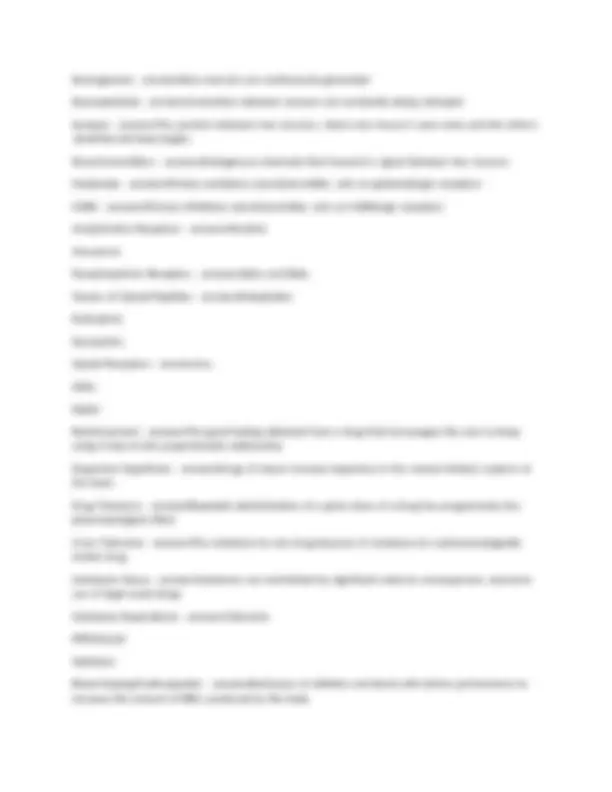
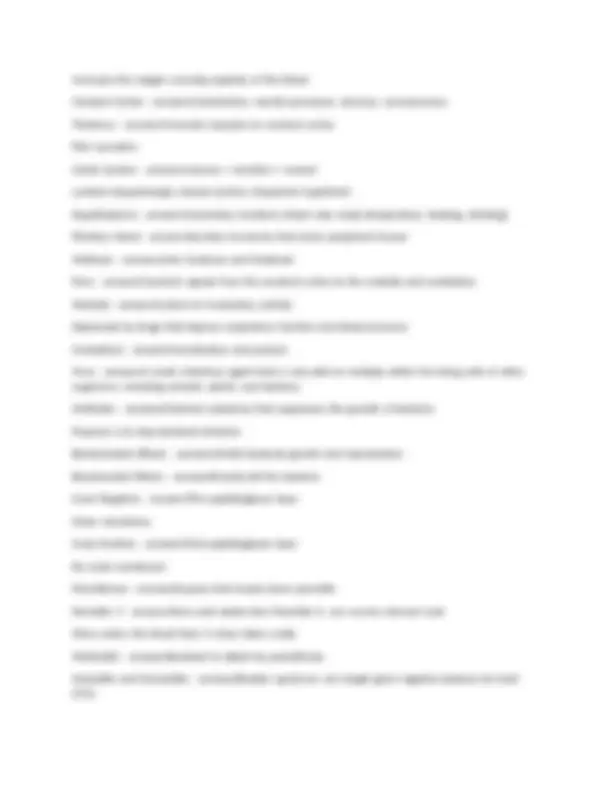
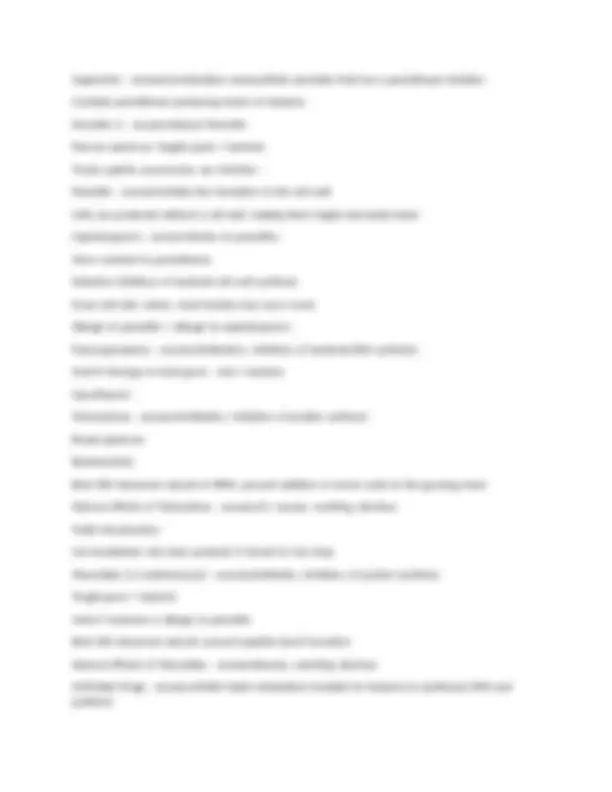
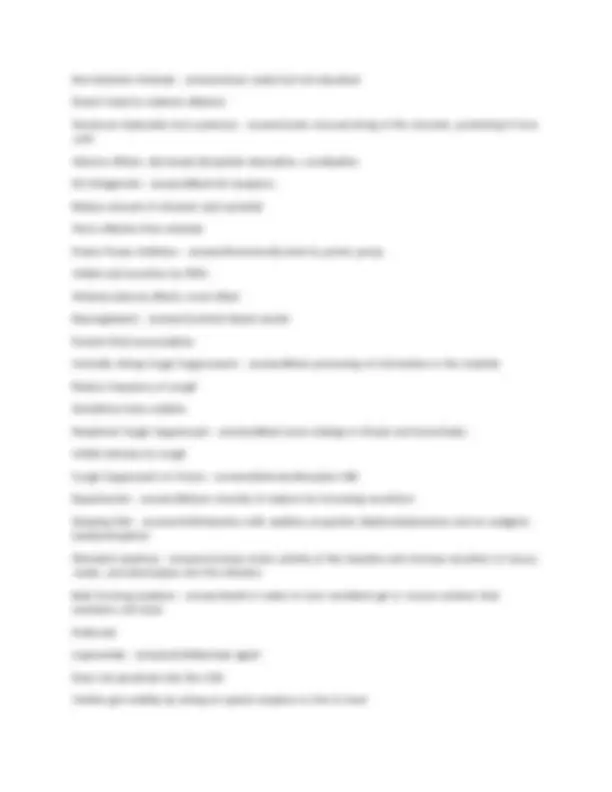
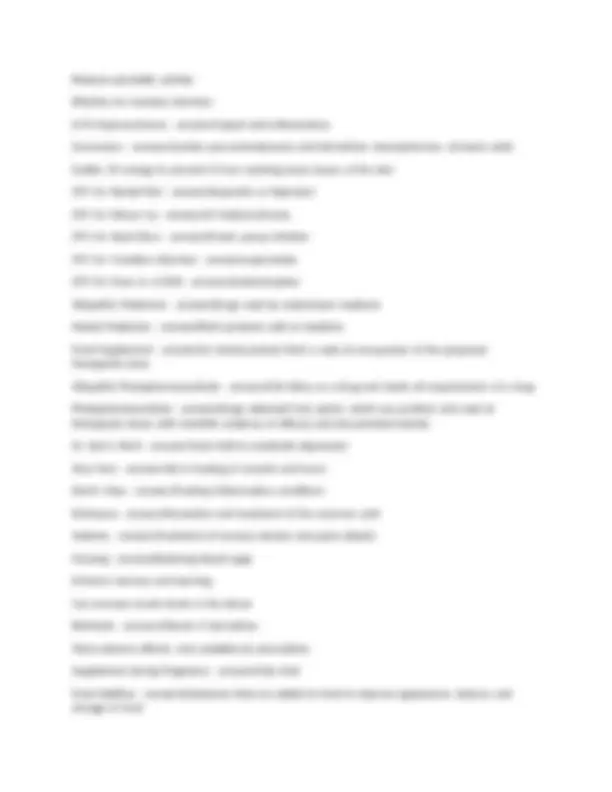
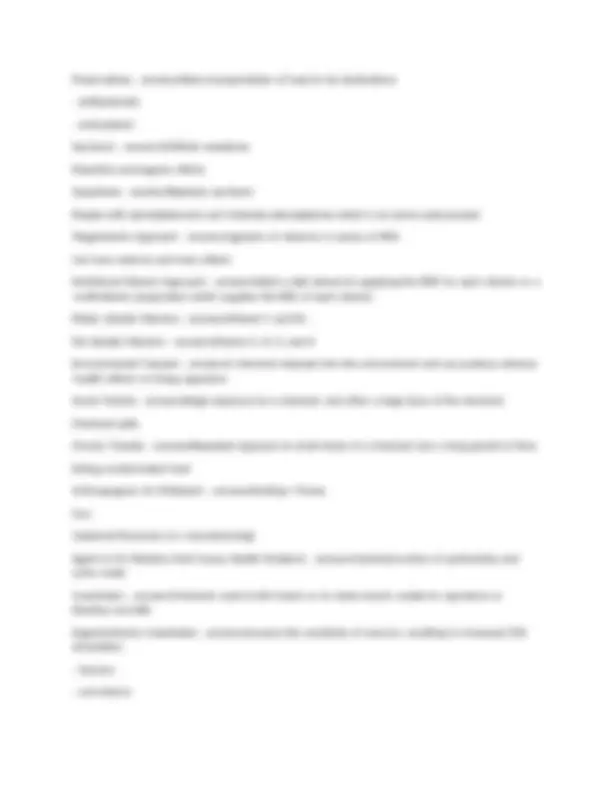



Study with the several resources on Docsity

Earn points by helping other students or get them with a premium plan


Prepare for your exams
Study with the several resources on Docsity

Earn points to download
Earn points by helping other students or get them with a premium plan
Community
Ask the community for help and clear up your study doubts
Discover the best universities in your country according to Docsity users
Free resources
Download our free guides on studying techniques, anxiety management strategies, and thesis advice from Docsity tutors
PHAR 100 – Final Exam University of California,
Typology: Exams
1 / 13

This page cannot be seen from the preview
Don't miss anything!








Codeine |- |answers0.5% |opium | Pain |relief Morphine |- |answers10% |opium Immense |pain |reliever Gold |standard |drug Curare |- |answersIndigenous |people |dipped |arrows, |causing |paralysis |to |animals Paul |Enrlich |(father |of |chemo) Gerhard |Domagk Alexander |Fleming Selman |Waksman Morton |- |answersOrganoarsenicals--> |syphilis Sulfa |drugs Penicillin Streptomyocin |(TB) Ether Receptor |- |answersMolecule |located |on |the |inside |or |outside |of |a |cell |that |has |a |regulatory |role |in | homeostasis Agonists |- |answersDrugs |that |bind |to |a |receptor |and |stimulate |it Antagonists |- |answersDrugs |that |bind |to |a |receptor |but |block |the |response |that |it |normally |elicits Dose-Response |Relationship |- |answersIntensity |is |proportional |to |dosage Low |dose |= |little |response; |not |enough |receptors |activated | Threshold |dose |= |enough |receptors |activated |to |elicit |response | Past |threshold |= |small |increments |in |dose |lead |to |increasing |intensity |in |response | Max |effect |= |maximal |response; |once |you |increase |the |dose |past |maximum |there |is |no |increase |in | response ED | 50 |- |answersDose |that |results |in |50% |of |the |maximum |effect
Dose |that |is |effective |in |50% |of |the |population Efficacy |- |answersThe |maximum |response |that |can |be |produced |by |a |drug Potency |- |answersThe |strength |of |the |drug | The |amount |that |must |be |given |in |order |to |get |a |certain |response Therapeutic |Range |- |answersThe |dose |of |a |drug |that |keeps |blood |concentrations |above |the |minimum |needed |for |a |response |but |below |the |toxic |response |concentration | In |between |ineffective |and |toxic Bioavailability |- |answersThe |fraction |of |the |administered |drug |that |enters |the |bloodstream |(i.e. |100% | for |IV |administration) Absorption |- |answersMovement |of |a |drug |from |site |of |administration |to |the |blood Distribution/Redistribution |- |answersMovement |of |a |drug |from |blood |to |the |site |of |action |(i.e. |tissue) Metabolism/Biotransformation |- |answersConversion |of |a |drug |to |a |different |chemical |compound; | occurs |mainly |in |the |liver Excretion |- |answersMoving |a |drug |and |its |metabolites |out |of |the |body Half |Life |- |answersTime |needed |for |the |liver |and |kidney |to |remove |half |of |the |drug |from |the |body Teratogenesis |- |answersDrug |produces |birth |defects Therapeutic |Index |(TI) |- |answers= |TD50/ED Higher |TI |= |Safer |Drug | Lower |TI |= |Greater |chance |of |toxicity TD | 50 |- |answersThe |dose |that |is |toxic |in |50% |of |the |population Drug-Drug |Interactions |- |answersOne |drug |changes |the |pharmacological |effect |of |a |second |drug |
Increases |the |oxygen |carrying |capacity |of |the |blood Cerebral |Cortex |- |answersCoordination, |mental |processes, |memory, |consciousness Thalamus |- |answersTransmits |impulses |to |cerebral |cortex Pain |sensation Limbic |System |- |answersmemory |+ |emotion |+ |reward | contains |dopaminergic |reward |centres; |Dopamine |hypothesis Hypothalamus |- |answersInvoluntary |functions |(heart |rate, |body |temperature, |feeding, |drinking) Pituitary |Gland |- |answersSecretes |hormones |that |acton |peripheral |tissues Midbrain |- |answersLinks |forebrain |and |hindbrain Pons |- |answersConducts |signals |from |the |cerebral |cortex |to |the |medulla |and |cerebellum Medulla |- |answersControl |of |involuntary |activity | Depressed |by |drugs |that |depress |respiratory |function |and |blood |pressure Cerebellum |- |answersCoordination |and |posture Virus |- |answersA |small, |infectious |agent |that |is |only |able |to |multiply |within |the |living |cells |of |other | organisms, |including |animals, |plants, |and |bacteria Antibiotic |- |answersChemical |substance |that |suppresses |the |growth |of |bacteria | Purpose |is |to |stop |bacterial |infection Bacteriostatic |Effects |- |answersInhibit |bacterial |growth |and |reproduction Bacteriocidal |Effects |- |answersDirectly |kill |the |bacteria Gram |Negative |- |answersThin |peptidoglycan |layer Outer |membrane Gram |Positive |- |answersThick |peptidoglycan |layer | No |outer |membrane Penicillinase |- |answersEnzyme |that |breaks |down |penicillin Penicillin |V |- |answersMore |acid |stable |than |Penicillin |G; |can |survive |stomach |acid | More |enters |the |blood |than |G |when |taken |orally Methicillin |- |answersResistant |to |attack |by |penicillinase Ampicillin |and |Amoxicillin |- |answersBroader |spectrum; |can |target |gram |negative |bacteria |(ie |treat | UTIs)
Augmentin |- |answersCombination |semisynthetic |penicillin |that |has |a |penicillinase |inhibitor | Combats |penicillinase |producing |strains |of |bacteria Penicillin |G |- |answersNatural |Penicillin | Narrow |spectrum; |targets |gram |+ |bacteria | Treats |syphilis, |pneumonia, |ear |infection |.. Penicillin |- |answersInhibits |the |formation |of |the |cell |wall Cells |are |produced |without |a |cell |wall, |making |them |fragile |and |easily |lysed Cephalosporins |- |answersSimilar |to |penicillins | More |resistant |to |penicillinase Selective |inhibitors |of |bacterial |cell |wall |synthesis Fever |and |skin |rashes; |renal |toxicity |may |occur |(rare) Allergic |to |penicillin |= |allergic |to |cephalosporins Fluoroquinolenes |- |answersAntibiotics; |Inhibitors |of |bacterial |DNA |synthesis | Oral/IV |therapy |to |treat |gram |- |and |+ |bacteria | Ciprofloxacin Tetracyclines |- |answersAntibiotics; |Inhibitors |of |protein |synthesis | Broad |spectrum | Bacteriostatic | Bind |30S |ribosomal |subunit |of |tRNA; |prevent |addition |of |amino |acids |to |the |growing |chain Adverse |Effects |of |Tetracylines |- |answersGI; |nausea, |vomiting, |diarrhea | Teeth |discoloration | Can |breakdown |into |toxic |products |if |stored |for |too |long Macrolides |(i.e |erythromycin) |- |answersAntibiotic; |Inhibitors |of |protein |synthesis | Target |gram |+ |bacteria | Used |if |someone |is |allergic |to |penicillin Bind |50S |ribosomal |subunit; |prevent |peptide |bond |formation Adverse |Effects |of |Macrolides |- |answersNausea, |vomiting, |diarrhea Antifolate |Drugs |- |answersInhibit |folate |metabolism |(needed |for |bacteria |to |synthesize |DNA |and | proteins)
No |negative |effect |on |sex |drive |or |testosterone Tested |and |99% |effective |in |China Grandparenting |- |answersA |process |where |new |regulations |do |not |apply |to |those |products |already |on |the |market | I.e. |sale |of |acetaminophen Analgesic |- |answersPain |reliever Antipyretic |- |answersFever |reducer Prostaglandins |- |answersEndogenous |substances |that |enhance |mediation |of |pain |and |fever | Have |a |role |in |inflammation Aspirin |MOA |- |answersInhibits |synthesis |of |prostaglandins | Also |inhibits |platelet |aggregation |and |clot |formation Aspirin |Adverse |Effects |- |answersTinnitus | Reyes |Syndrome |(children) | Allergic |Reactions | Gastric |Irritation Acetaminophen |MOA |- |answersInhibit |prostaglandin |synthetases |(cooxygenase |I |and |II) |which |are | responsible |for |the |formation |of |prostaglandins Acetaminophen |Adverse |Effects |- |answersOD |--> |liver |failure NSAIDs |- |answersMost |effective |OTC |anti-inflammatory NSAIDs |MOA |- |answersReversible |inhibition |of |prostaglandin |synthesis NSAIDs |Adverse |Effects |- |answersGastric |irritation |(less |than |that |caused |by |uncoated |ASA) | Skin |rash Dizziness |and |blurred |vision Fluid |retention Antihistamines |MOA |- |answersBlock |histamine |receptors; |inhibit |binding |of |histamine; |decrease | allergic |symptoms First |Generation |Antihistamines |- |answersProduce |drowsiness |and |sedation Second |Generation |Antihistamines |- |answersPreferred |because |they |don't |cause |sedation | Ex. |cetirizine, |loratidine)
Non-Systemic |Antacids |- |answersGiven |orally |but |not |absorbed | Doesn't |lead |to |systemic |alkalosis Aluminum |Hydroxide |(non-systemic) |- |answersCoats |mucosal |lining |of |the |stomach, |protecting |it |from |acid | Adverse |effects: |decreased |phosphate |absorption, |constipation H2 |Antagonists |- |answersBlock |H2 |receptors | Reduce |amount |of |stomach |acid |secreted | More |effective |than |antacids Proton |Pump |Inhibitors |- |answersPermanently |bind |to |proton |pump | Inhibit |acid |secretion |by |90%+ | Minimal |adverse |effects; |most |effect Decongestants |- |answersConstrict |blood |vessels | Prevent |fluid |accumulation Centrally |Acting |Cough |Suppressants |- |answersBlock |processing |of |information |in |the |medulla | Reduce |frequency |of |cough | Sometimes |have |codeine Peripheral |Cough |Suppressant |- |answersBlock |nerve |endings |in |throat |and |bronchioles | Inhibit |stimulus |to |cough Cough |Suppressant |of |Choice |- |answersDextromethorphan |HBr Expectorants |- |answersReduce |viscosity |of |septum |by |increasing |secretions Sleeping |Aids |- |answersAntihistamine |with |sedative |properties |(diphenyhydramine) |and |an |analgesic | (acetaminophen) Stimulant |Laxatives |- |answersIncrease |motor |activity |of |the |itnestine |and |increase |secretion |of |mucus, |water, |and |electrolytes |into |the |intestine Bulk |Forming |Laxatives |- |answersSwell |in |water |to |form |emollient |gel |or |viscous |solution |that | maintains |soft |stool | Preferred Loperamide |- |answersAntidiarrheal |agent | Does |not |penetrate |into |the |CAN | Inhibits |gut |motility |by |acting |on |opioid |receptors |in |the |GI |tract |
Preservatives |- |answersAllow |transportation |of |food |to |far |destinations |
DDT |- |answersAn |organochlorine |insecticide | Used |to |control |malaria |but |stopped |because |insects |developed |resistance | Has |developmental |and |reproductive |effects | Has |been |phased |out Organophosphorus |Insecticides |- |answersSmall |impact |on |environment | Highly |toxic |to |humans | Absorbed |via |skin | Inhibit |acetylcholinesterase | Decreases |heart |rate | Death |via |respiratory |failure Herbicides |- |answersCapable |of |killing |or |injuring |plants Agent |Orange |- |answersHerbicide | Mimics |plant |growth |hormones, |causing |uncontrolled |and |unsustainable |growth | Results |in |plant |death | TCDD |toxicity |- |impairment |of |liver |and |CNS |function, |cancer, |birth |defects Paraquat |- |answersHerbicide | Highly |toxic |when |ingested | Cellular |damage |to |lungs | Death |due |to |lung |damage Main |Toxic |Components |of |Lead |- |answersLead |oxide |and |tetraethyl |lead Lead |Toxicity |Symptoms |- |answersAppetite |loss | Coordination |loss | Kidney |damage | Anemia Chelating |Agent |(EDTA) |- |answersLead |toxicity |treatment | Binds |to |lead |and |produces |a |water |soluble |complex |that |can |be |excreted Mercuric |Mercury |- |answersExposure |from |vapors | Accumulates |in |the |kidneys | Very |toxic
Chemo |Drugs |- |answersSlow |the |growth |of |rapidly |dividing |cancer |cells | Inhibit |DNA |synthesis, |protein |synthesis |and |cell |division Alkylating |Agent |- |answersBind |to |and |interfere |with |DNA |replication Mitotic |Inhibitors |- |answersAffect |microtubule |function |and |the |formation |of |spindle |fibers | Prevent |cell |division Hormones |and |Hormone |Antagonists |- |answersTreat |hormone |sensitive |tumors |by |suppressing |cell | division Biologicals |- |answersInhibit |cell |replication |by |blocking |cytokines |which |normally |control |cell |cgrowth Combination |Chemotherapy |- |answersChemotherapeutic |drugs |often |used |in |combination